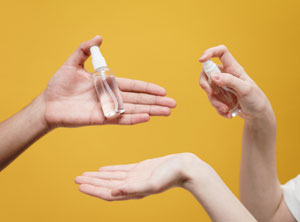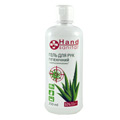 Due to the 2019–2020 coronavirus pandemic, hand sanitisers have shifted from a commodity to a luxury, since a lot of people suddenly realised the importance of keeping their hands clean. So it has become nearly impossible to buy hand disinfectants. Luckily, they are very easy to make at home. Today, let us tell you how to make your own hand sanitiser using easily available ingredients.
Due to the 2019–2020 coronavirus pandemic, hand sanitisers have shifted from a commodity to a luxury, since a lot of people suddenly realised the importance of keeping their hands clean. So it has become nearly impossible to buy hand disinfectants. Luckily, they are very easy to make at home. Today, let us tell you how to make your own hand sanitiser using easily available ingredients.
Personal hygiene and home hygiene are important safety measures that help to slow down the spreading of various infections, including SARS-CoV-2, a contagious virus responsible for the current pandemic of COVID-19. To keep your house or flat infection-free, you should regularly air the rooms and clean them using special household chemicals with disinfectant properties. As for personal hygiene, you should regularly wash your hands with soap; if you can’t wash your hands, using hand sanitiser is the next best thing.
Hand sanitiser, also known as hand antiseptic, hand disinfectant, handrub or hand rub, is a liquid or gel used to decrease infectious agents on the hands. As a rule, hand sanitisers are based on alcohol (ethanol, isopropyl alcohol or n-propanol), and sometimes they also contain other antibacterial agents, as well as thickeners, fragrances and moisturising agents.
Hand antiseptics can be easily made at home. For this, you will need a few easily available ingredients and bottles to store sanitiser in. If you’re planning to make liquid sanitiser, opt for spray bottles, which make it much easier to apply. Here are a few sanitiser recipes that you can try at home.
Home-made Hand Sanitiser Recipes
The most important ingredient of home-made hand sanitiser is ethanol with a concentration of 70% or higher. Other ingredients that you may need include essential oils (in addition to acting as a natural fragrance, they have an antibacterial effect) and moisturising agents (for example, glycerine or aloe vera gel). Don’t try to make several litres of antiseptic at once; it’s better to make it in small batches, store in a cool, dark place, and apply as needed.
WHO-recommended Handrub
The World Health Organization released a guide for manufacturing handrub back in 2010. The recipe received renewed interest due to hand sanitiser shortages in the wake of the coronavirus pandemic. To make WHO-recommended hand antiseptic at home, you’ll need:
- 833 ml 96% ethanol
- 42 ml 3% hydrogen peroxide
- 15 ml 98% glycerol
Pour ethanol into a 1 l bottle. Add hydrogen peroxide and glycerol, then top up the bottle with distilled or cold boiled water. Screw the cap and shake the bottle gently to mix all ingredients together. Pour the sanitiser into its final containers and use it as often as needed.
Chlorhexidine-based Hand Antiseptic
Ingredients:
- 5 tbsp vodka
- 1 tbsp cold boiled water
- 5 drops lavender essential oil
- 1 tsp aloe vera gel/leaf juice
- 5 g chlorhexidine
Mix all ingredients together and let the mixture steep before pouring it into bottles. Vodka and chlorhexidine are responsible for the sanitiser’s antiseptic effect, aloe vera softens the skin, moisturises it and prevents irritation, and lavender essential oil gives the mixture a light, calming smell and helps to kill microbes.
Hand Sanitiser with Calendula or Chamomile Tincture
- 50 ml calendula or chamomile alcohol tincture
- 50 ml water
- 30 ml glycerine
- 5 ml lemon essential oil
You can make this hand sanitiser if you have no access to pure ethanol. Glycerine will keep the skin of your hands from drying out, and lemon essential oil has a nice, fresh smell and complements the antibacterial effect of ethanol. In addition, calendula and chamomile have antiseptic and anti-inflammatory properties.
Hand Sanitiser with Aloe Vera Gel
- 50 ml calendula or chamomile alcohol tincture
- 7 drops tea tree essential oil
- 1 tbsp aloe vera gel
This sanitiser recipe is based on the previous one. Here, the disinfectant effect of ethanol is complemented by the antiseptic properties of tea tree essential oil, and aloe vera gel is responsible for moisturising and softening the skin of the hands. Mix all ingredients together and pour into a bottle for further use.
How to Make Home Surface Disinfectant
Keeping your house or flat clean is just as important as washing your hands or using hand sanitiser. Depending on the situation, you may need to disinfect all surfaces in your home or only some of them. Here are several antiseptic household cleaners that you can easily make yourself.
- hydrogen peroxide solution (1 cup hydrogen peroxide per 10 l water
- concentrated salt solution
- ammonia solution (1 part ammonia and 3 parts water)
- concentrated vinegar or lemon juice solution (1 part vinegar/lemon juice and 3 parts water)
- any off-the-shelf chlorine-based disinfectant
It is important to note that ethanol-based disinfectants are rarely used as household cleaners because they can have a corrosive effect on certain materials. Moreover, it is very dangerous to combine alcohol and chlorine-based disinfectants.
In addition to cleaning and disinfecting the floors in your house or flat, it is very important to disinfect all furniture, kitchen surfaces, as well as sinks, toilet bowl, bath or walk-in shower, bathroom fixtures, etc. You can use any of the above-listed cleaners. Some surfaces can be treated with a probiotic household cleaner, such as Organics Healthy Life Probiotic Disinfectant Spray. Finally, you can pour several drops of essential oil (for example, tea tree, fir, pine, eucalyptus, lemon) into an essential oil diffuser to disinfect the air in your house or flat.
In our online shop Organic Store, you can buy essential oils and aloe vera gel for home-made hand sanitisers, as well as probiotic, organic and eco household cleaners, and many other products for personal and home hygiene. We offer affordable prices, convenient payment methods, and international delivery to most corners of the world.
Hand Sanitisers in Our Store
Hand Sanitar Hygienic Hand Gel with Antiseptics, 250 ml |
